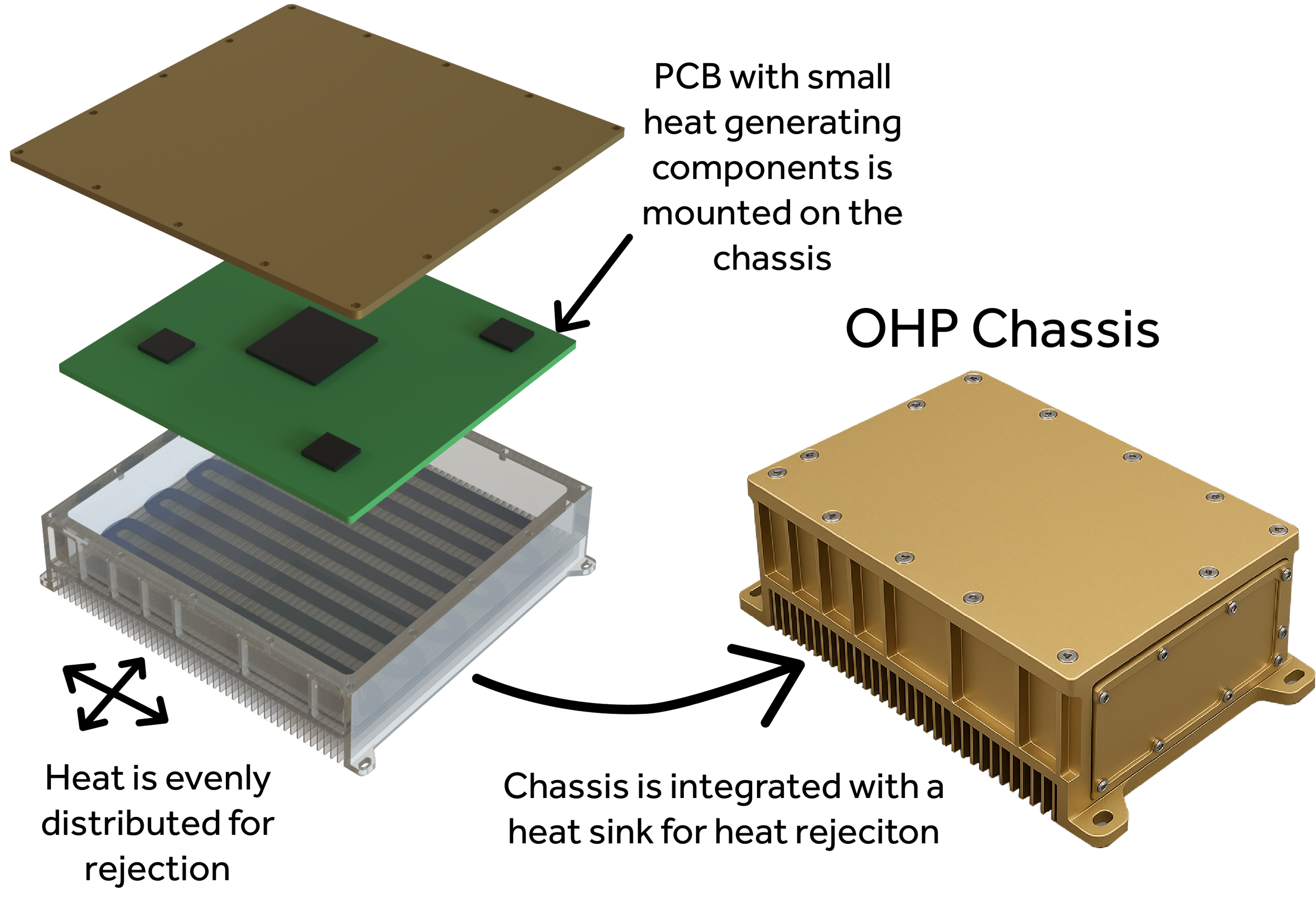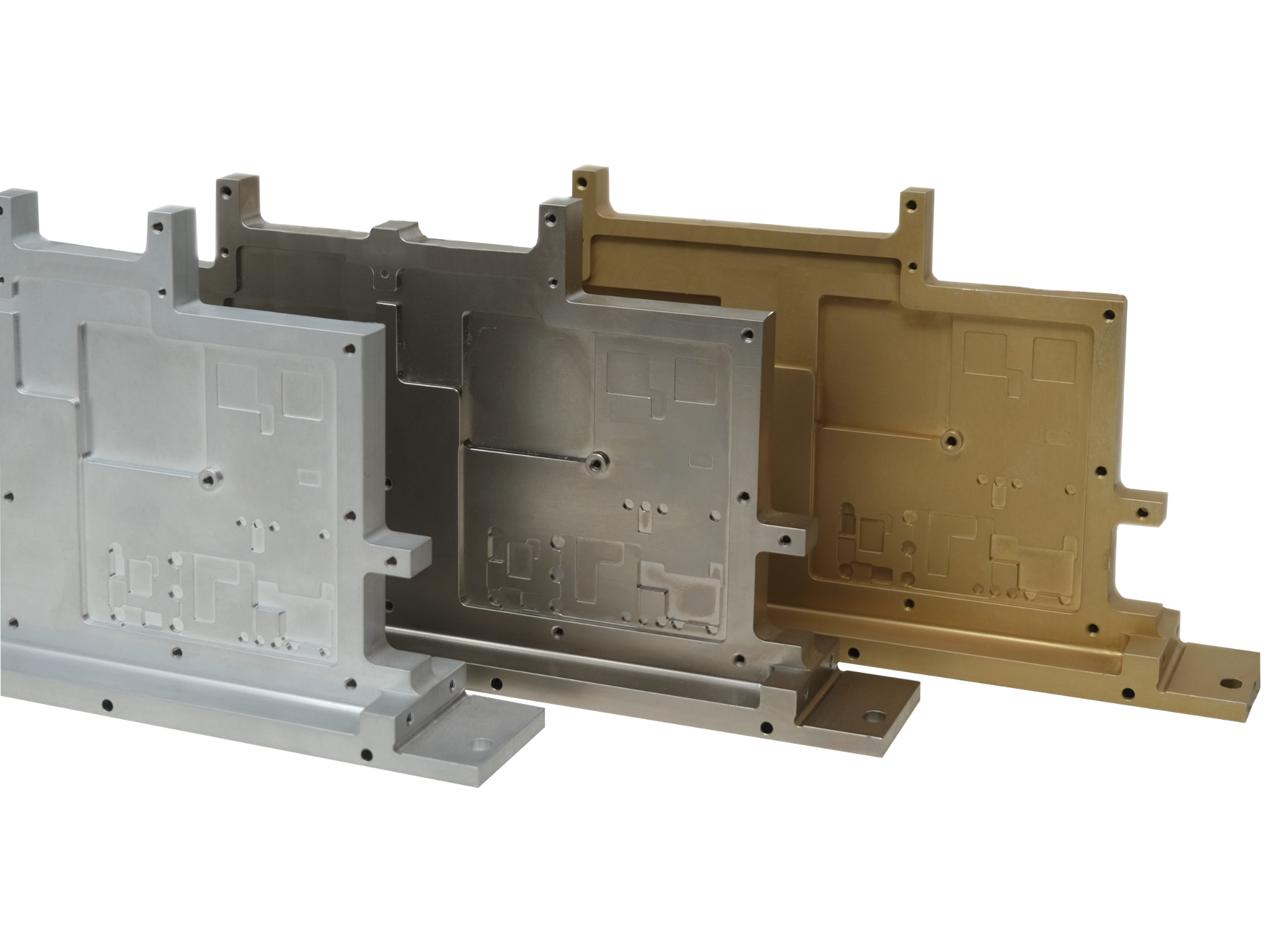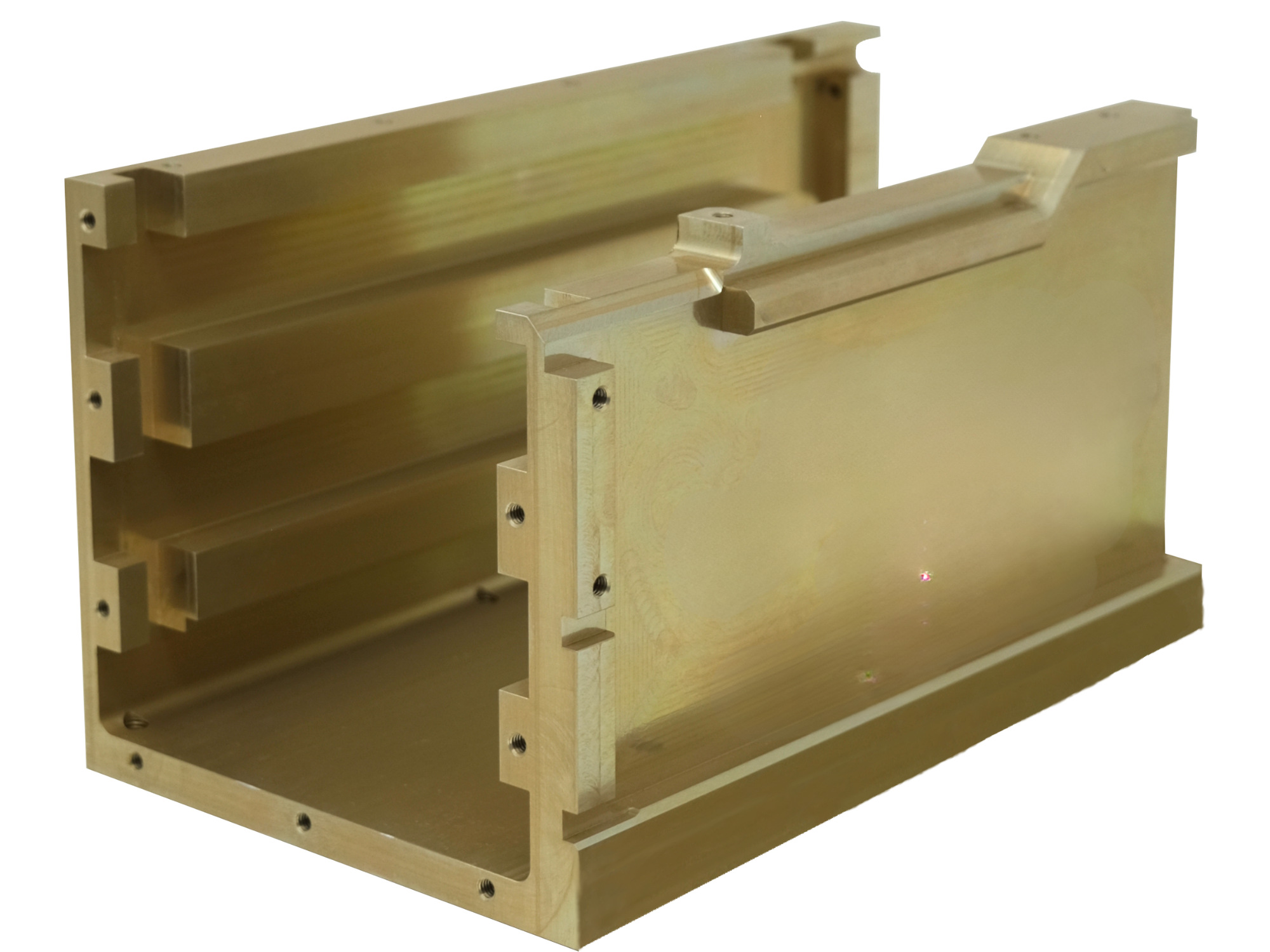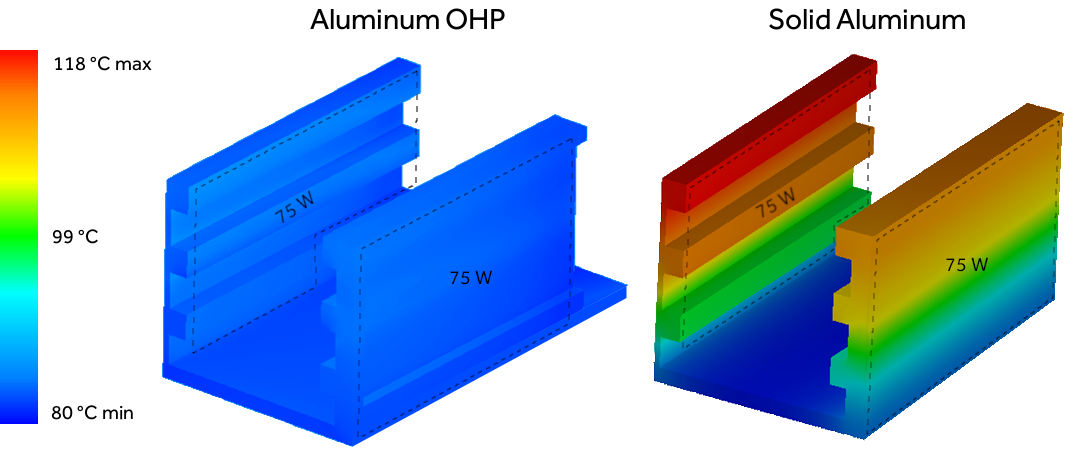OSCILLATING HEAT PIPE
Chassis
Chassis are enclosures that structurally house internal circuit cards and other devices such as processors, optical components, RF modules, and Li-ion cells. They are designed to:
secure internal components against shock, vibration, launch, and other environmental loads
conduct heat away from those components to external heat sinks
ThermAvant's OHP-embedded Chassis radically improve thermal conductivity in the x-y and z-planes while preserving structural integrity. ThermAvant Technologies’ has developed and manufactured these chassis to integrate with spacecraft radiators, liquid-cooled cold plates, and air-cooled sidewalls.
Aerospace • Defense • Communications • Edge Computing
OHP Chassis Product Gallery
The products below show customized solutions with proprietary details removed.
Electronics Chassis in Multiple Finishes Examples include nickel, bare aluminum, and chem film
Nickel surface coating allows for direct die attachment
Electric Aircraft Lithium Ion Battery ChassisHouses 96, 1650-style cells
Minimum 0.06 inch ~1.5 mm (thickness)
Dielectic coating
High Flux Electronics Chassis AssemblyCustomized mounting features
OHP allows for adverse gravity ground testing
For processors, power electronics, and RF subsystems
Circuit Card Heat Sink ChassisConfigured for 3U card sizes
Channel routing in x, y, and z directions
Mounting features for attachment of enclosure walls
Simple OHP Chassis
In this aerospace application, the customer had multiple devices on multiple circuit cards that mounted vertically to the OHP-embedded chassis (cover removed). The OHP-embedded chassis has selectively located microchannels to route heat from the vertical plane where heat is acquired and rejects the heat to the base of the chassis, which is connected to the vehicle’s larger thermal control system.
| Aluminum OHP | Solid Aluminum | |
|---|---|---|
| Thermal performance | 11 °C per 120 W |
35 °C per 120 W 3.2× worse than OHP |
| Mass | 995 g |
1049 g 1.1× worse than OHP |
| Shape & structure |
• Al 6061 T4 or T6 sized to approx. 12" × 8" × 1.0" thick with 0.1" min. thickness at center (available in multiple coatings, platings, or films) • Al OHP typically has 5% less stiffness and 5% higher modal frequencies than solid Al |
|
| Temperature range | -20 °C to 75 °C | |
| Heritage or maturity level |
• 200+ demonstrated OHP chassis units for air and space applications, with approx. 30 units currently on orbit • Qualified through MIL-STD thermal cycling, vibration, shock, and pressure cycling (TRL 9) |
|
Simple OHP Chassis vs. Alternatives
Complex OHP Chassis
In this on-board vehicular application, the customer had three 3U circuit card assemblies on heat frames, each dissipating approximately 50 W, and the heat frames contacted the OHP-embedded chassis’ vertical rails via wedgelock attachment so that the chassis acquired 150 W of waste heat from the frames and rejected it through the chassis’ horizontal base plate interface.
ThermAvant Techonologies’ developed an OHP-embedded chassis where fluidly-filled microchannels traverse between the vertical walls and horizontal base plate to rapidly conduct heat with < 5 °C dT between the hottest, top-most rails to the bottom baseplate. This is a 7x increase in thermal conductance as compared to a solid Al chassis. ThermAvant Technologies’ OHP-embedded chassis was qualified through a wide range of operating conditions (e.g. variable heat loads, variable gravity environments, and variable rejection temperatures).
Complex OHP Chassis vs. Alternatives
| Aluminum OHP | Solid Al | |
|---|---|---|
| Thermal performance | 5 °C per 150 W |
35 °C per 150 W 7.0x worse than OHP |
| Mass | 1351 g |
1486 g 1.1x worse than OHP |
| Shape & structure |
• Al 6061 T4 or T6 sized to approx. 10" × 5" × 1.0" thick with 0.15" min. thickness at vertical walls (available in multiple coatings, platings or films) • Al OHP typ. has 5% less stiffness and 5% higher modal frequencies than solid Al |
|
| Temperature range | -55 °C up to +105 °C | |
| Heritage or maturity level |
• +100s fielded OHP units for airborne, ground and spacecraft applications (TRL 9) • Qualified thru MIL-STD thermal cycling, vibration, shock and pressure cycling |
|
OHP Chassis Tech Specs
Design flexibility and SWaP-C optimization without compromise.
-
Al and Al composites (from 0 to T6 temper) (most common for chassis)
Cu and Cu composites, including Copper-Molybdenum
Ni alloys, including Invar and Kovar
-
Water
Ketones
Alkanes
Alcohols
Hydrochlorofluorocarbons
Perfluorocarbons
Hydrofluorocarbons
More from cryogenics (below 100 K) to liquid metals (above 1,000 °C)
-
Heat fluxes range from less than 1 W/cm2 to greater than 300 W/cm2
Heat loads per OHP from 1 watt to greater than 10,000 watts
Long-distance OHPs operable at 2 cm length to 2 m length
Gravity independent (e.g., 0.3 m OHPs successfully tested at 9g of adverse gravity and 1.2m OHP successfully tested at 1g adverse gravity)
-
From less than 1 mm in thickness to up to 2 m in length
Customizable widths from less than 2 cm to greater than 1 m
Flat or 3D plate with bosses, through or blind holes, etc.
Platings and dielectric coatings
Chemical conversion coating and anodization
Other features (e.g., integral fin structures, fans, thermoelectrics, etc.)
OHP Chassis Frequently Asked Questions
-
Our embedded OHP chassis combine rugged mechanical support with advanced thermal management by integrating Oscillating Heat Pipes (OHPs) directly into the chassis structure. These capillary-driven, passive cooling loops rapidly move heat away from high-flux components or rail interfaces with VPX cards—no pumps, fans, or external hardware required. Each chassis is engineered to serve as both the mounting surface and the primary thermal pathway, reducing thermal resistance and eliminating the need for bulky cold plates or complex cooling assemblies. To enable high-power embedded computing formats our chassis are deployed in mission-critical environments including aircraft, UAVs, spacecraft, military ground systems, autonomous vehicles, and industrial platforms.
-
Lead times can be as short as 4 weeks for recurring hardware. Custom designs and new builds typically range from 4 to 6 months for first unit delivery, depending on complexity.
-
OHPs can: 1) incorporate monolithic or brazed fin structures for convective cooling (natural or forced), 2) integrate pumped fluid loop heat exchangers; and 3) interface with a base plate/doubler in the next higher assembly.
-
ThermAvant offers several common form factors to support lab demonstrations and risk reducing efforts but OHPs will typically be designed for the boundary conditions, thermal loading, and heat map of a specific part.
-
OHP chassis are multifunctional operating as: 1) passive thermal spreaders distributing heat from high flux electronics interfaces or circuit card assemblies and 2) thermal transporters, moving the heat to the rejection sink with minimal temperature rise over the travel distance of the part.
-
Yes. The OHP is embedded directly into the chassis, with no separate components to fail or add bulk. It appears and functions as a solid structural piece but passively moves heat with zero moving parts. Just specify the form factor—ThermAvant builds to match existing structural geometry as a drop in replacement, thermally enabled solution.
-
Pulsating Heat Pipes (PHPs) and Oscillating Heat Pipes (OHPs) refer to the same technology. The terms are used interchangeably in the industry. Regardless of terminology, the focus should be on the efficient heat transfer capabilities and applications of the technology.
-
Yes. OHPs can be manufactured with through-holes and threaded or tapped features, allowing for structural mounting to higher-level assemblies and seamless attachment to critical components.
-
Yes. OHPs can be designed and fabricated with complex external geometries and intricate internal channel routing—without compromising the structural integrity of the component.
-
OHP microchannels form structural "I-beam" features within the part’s cross-section. This allows an OHP to retain most of the strength and stiffness of the base material. ThermAvant can provide effective structural properties to support efficient modeling during preliminary design stages at the system level.
-
OHPs offer superior thermal performance due to their structural microchannels and complex routing capabilities. They can reduce part thickness, absorb heat closer to critical components, and more effectively isothermalize rejection surfaces. In contrast, VCs often require greater thickness to maintain rigidity and survive harsh environments. The internal wick structures of both VCs and CCHPs limit their performance and design flexibility for complex 3D geometries.
-
No. OHP drop-in replacements typically reduce mass compared to solid material equivalents. Microchannels are machined into the raw material, and the voids are partially filled with a low-density working fluid.
-
Cold-start behavior is well-characterized through ThermAvant's proprietary limit models and empirical data. When power is applied, OHPs transition smoothly from low-conductance conditions into high-performance nucleate boiling regimes as temperatures rise.
-
Full-fidelity modeling of OHPs is complex. ThermAvant can support your design by providing either 1) effective thermal conductivity values or 2) vapor-node model inputs to accelerate system-level thermal simulations.
-
ThermAvant has manufactured OHPs ranging from meter-scale dimensions to as small as centimeter-scale. Multi-layer OHPs for structural components can be fabricated, and thicknesses have been demonstrated down to the millimeter scale, depending on material constraints.
-
OHPs have been tested in adverse gravitational orientations without major effects on thermal performance compared to traditional wick based heat pipe/vapor chamber solutions. OHPs operate through nucleate boiling and local, high pressure deltas that have sufficient capability to overcome external body forces.
-
OHPs are manufactured in 4 major steps: 1) initial machining, 2) bonding 3) final machining 4) fluid charging/sealing. Taking aluminum parts as a reference: OHPs will be roughly 3-5x the price of a solid aluminum, precision machined equivalent due to the added manufacturing steps. Items that will drive unit cost are heat map complexity, final part GD&T, part size, material, etc. OHPs provide system level benefits to mass, space claim, thermal performance, and price (reduction in system level complexity) that offset the recurring hardware price. Please engage the ThermAvant business development team for more information.
You Bring the Mission.
We Bring the Solution.
Product Development. Manufacturing. Testing.
From concept to final delivery, ThermAvant partners with your team to design and manufacture OHP-embedded solutions that meet the exact needs of your system.
We support every step:
Collaborative design and modeling based on your layout and power profile
In-house prototyping (in-house brazing and CNC machining capabilities)
On-site lab facilities with high fidelity thermal verification testing
Precision manufacturing for high-volume delivery with robust demand schedules
